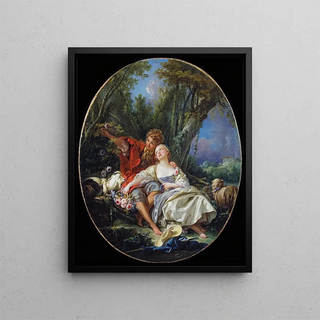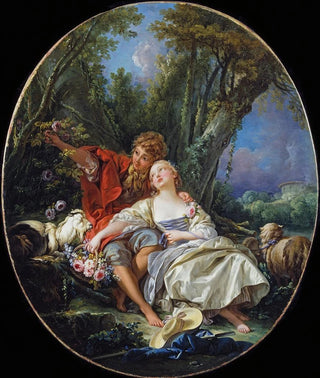Art print | Berger et bergère au repos - François Boucher Source: Reproduction | Berger et bergère au repos - François Boucher


View from behind

Frame (optional)
In the rich and varied panorama of Rococo art, the art print "Shepherd and Shepherdess at Rest" by François Boucher stands out for its delicacy and timeless charm. This painting transports us to a pastoral world where nature and love meet, creating an atmosphere of serenity and beauty. The characters, lost in contemplation, seem suspended in a moment of tenderness and intimacy, inviting the viewer to share their tranquility. The soft light bathing the scene evokes the first rays of dawn, while the bucolic landscape stretches to infinity, promising an escape from daily worries. This work, emblematic of Boucher's style, is a true ode to simple life and harmony between man and nature.
Style and uniqueness of the work
Boucher's style is characterized by bold use of colors and shapes, creating compositions that are both dynamic and harmonious. In "Shepherd and Shepherdess at Rest," the painter uses delicate pastel shades that evoke the lightness and freshness of spring. The graceful curves of the characters, as well as the meticulous details of the flowers and foliage, testify to a keen sense of observation and remarkable technical mastery. The expressions of the two protagonists, both dreamy and serene, capture genuine emotion, immersing the viewer in a universe of tenderness and romanticism. The scene is enveloped in an atmosphere of peace, where time seems to stand still, allowing for deep and soothing contemplation.
The artist and his influence
François Boucher, born in 1703, is one of the most emblematic artists of 18th-century France. A student of François Le Moyne, he developed a unique style that combines sensuality and lightness, making him a major representative of the Rococo movement. His career is marked by prolific production of works, ranging from easel paintings to wall decorations, including book illustrations. Boucher was able to capture the spirit of his time, influencing many contemporary and future artists. His innovative approach to the depiction of bodies and landscapes opened

Matte finish

View from behind

Frame (optional)
In the rich and varied panorama of Rococo art, the art print "Shepherd and Shepherdess at Rest" by François Boucher stands out for its delicacy and timeless charm. This painting transports us to a pastoral world where nature and love meet, creating an atmosphere of serenity and beauty. The characters, lost in contemplation, seem suspended in a moment of tenderness and intimacy, inviting the viewer to share their tranquility. The soft light bathing the scene evokes the first rays of dawn, while the bucolic landscape stretches to infinity, promising an escape from daily worries. This work, emblematic of Boucher's style, is a true ode to simple life and harmony between man and nature.
Style and uniqueness of the work
Boucher's style is characterized by bold use of colors and shapes, creating compositions that are both dynamic and harmonious. In "Shepherd and Shepherdess at Rest," the painter uses delicate pastel shades that evoke the lightness and freshness of spring. The graceful curves of the characters, as well as the meticulous details of the flowers and foliage, testify to a keen sense of observation and remarkable technical mastery. The expressions of the two protagonists, both dreamy and serene, capture genuine emotion, immersing the viewer in a universe of tenderness and romanticism. The scene is enveloped in an atmosphere of peace, where time seems to stand still, allowing for deep and soothing contemplation.
The artist and his influence
François Boucher, born in 1703, is one of the most emblematic artists of 18th-century France. A student of François Le Moyne, he developed a unique style that combines sensuality and lightness, making him a major representative of the Rococo movement. His career is marked by prolific production of works, ranging from easel paintings to wall decorations, including book illustrations. Boucher was able to capture the spirit of his time, influencing many contemporary and future artists. His innovative approach to the depiction of bodies and landscapes opened






